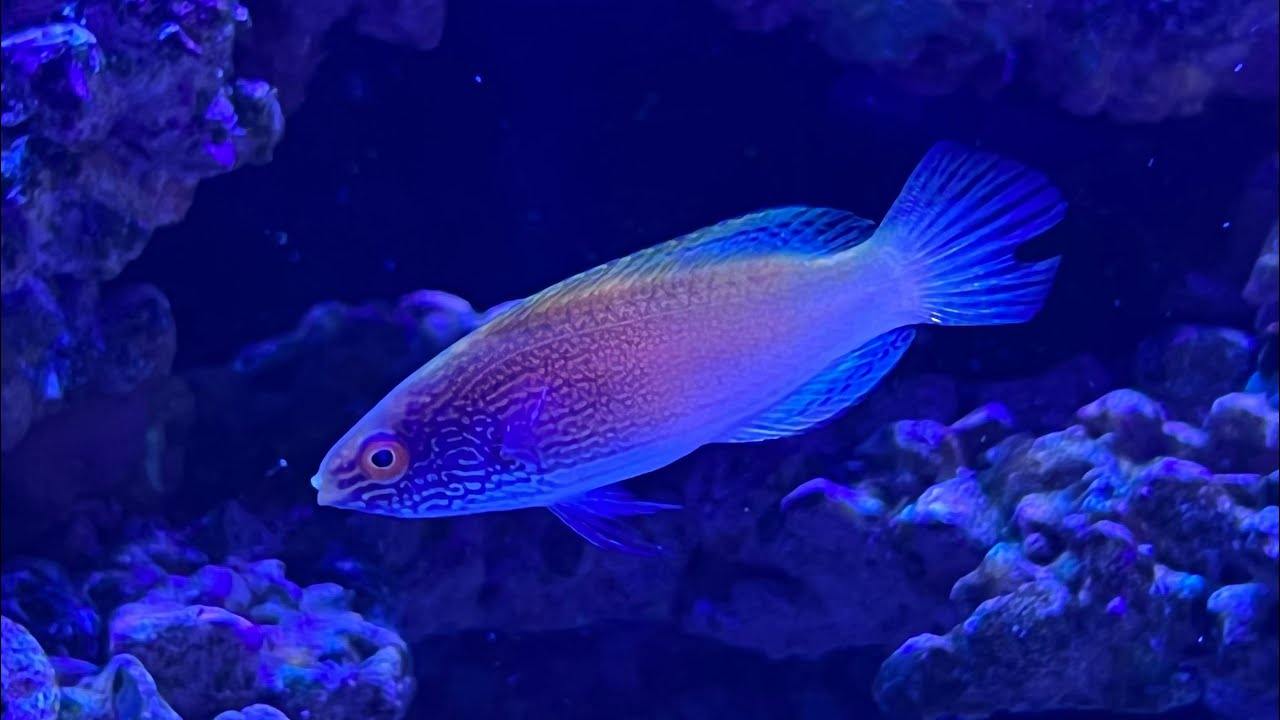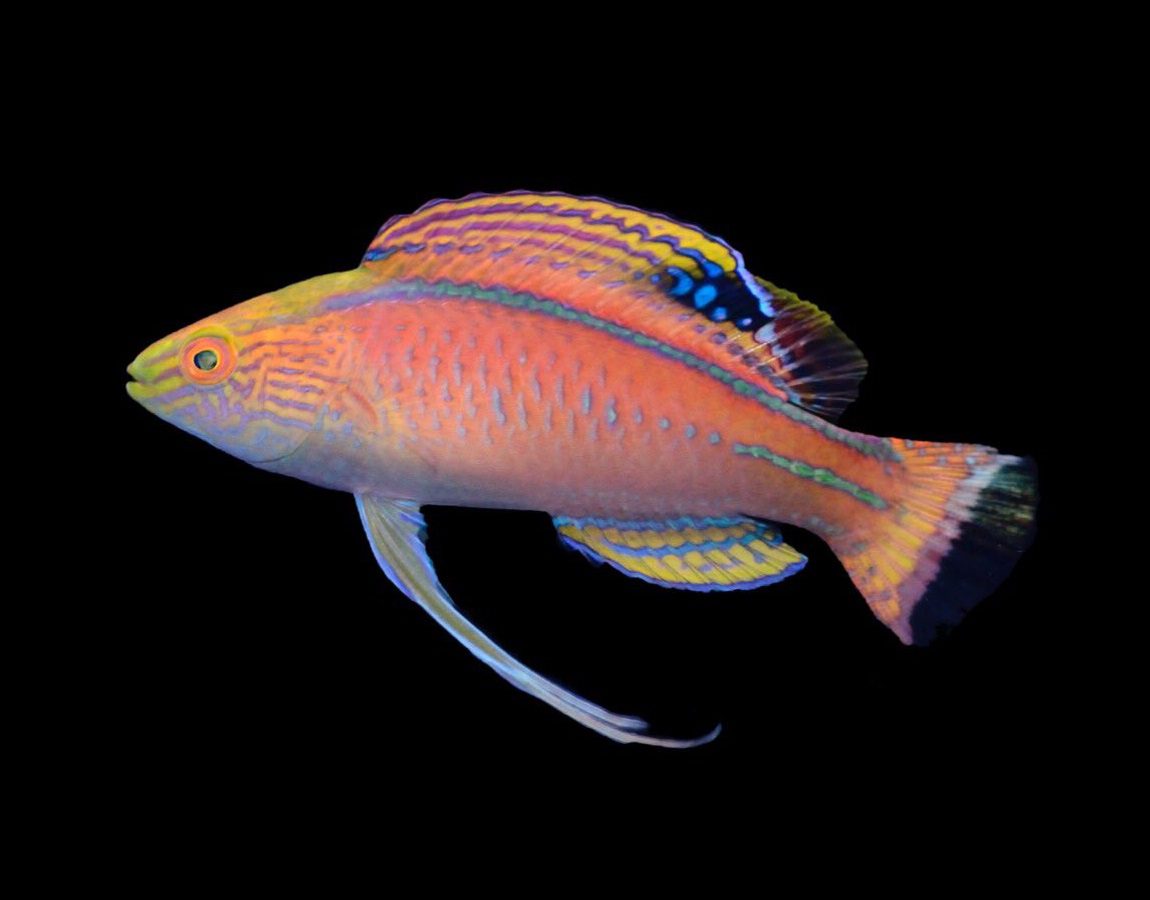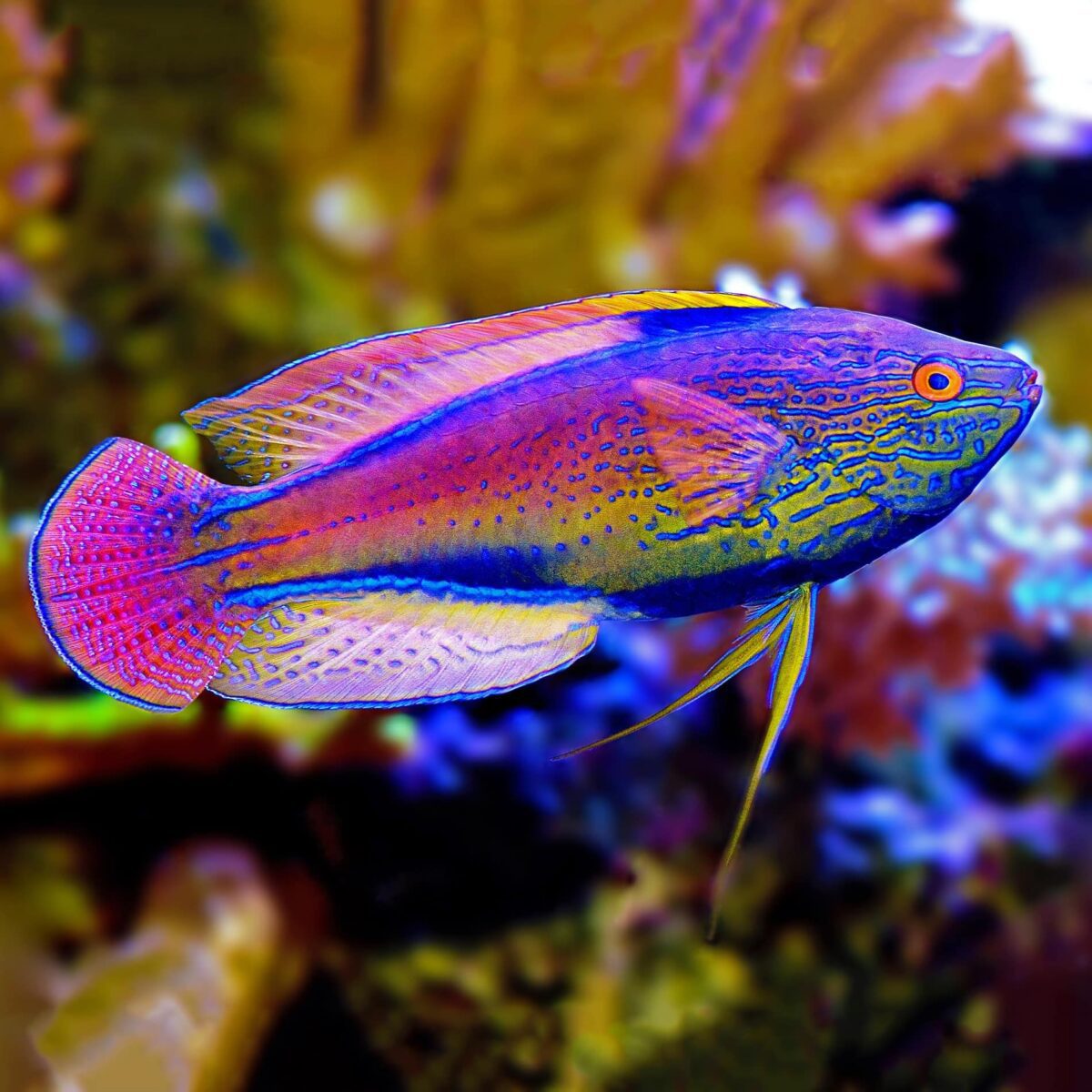Do you dream of crafting an underwater paradise that captures the essence of the ocean’s mystical beauty? Imagine integrating the vibrant Cirrhilabrus rhomboidalis, a sea gem, into your aquascape. With its striking appearance and unique characteristics, this species has the potential to transform your marine aquarium into a living piece of art.
- Cirrhilabrus rhomboidalis is a visually stunning wrasse species highly sought after in the aquarium trade.
- Its vibrant colours and distinctive markings make it a lively addition to any marine aquarium.
- This species requires specific care and a suitable tank environment to thrive.
- By incorporating Cirrhilabrus rhomboidalis into your aquascape, you can create an enchanting underwater world that showcases the beauty of the ocean.
- This striking species can bring life and elegance to your marine aquarium with proper care and attention.
Whether you are a seasoned aquarist or a beginner, adding the captivating Cirrhilabrus rhomboidalis to your collection can be a rewarding experience. Its vibrant colours, unique markings, and graceful movement will undoubtedly captivate the attention of anyone who sees your marine aquarium.
So, why wait? Dive into the world of marine fish care and consider adding the mesmerizing Cirrhilabrus rhomboidalis to your aquascape. Let this gem of the sea enhance the beauty of your underwater paradise and create a living piece of art right in your own home.
Key Takeaways:
- Cirrhilabrus rhomboidalis is a visually stunning wrasse species that can enhance the aesthetics of your marine aquarium.
- Proper care and a suitable tank environment are essential for the well-being of Cirrhilabrus rhomboidalis.
- This species brings vibrant colours, unique markings, and graceful movement to your underwater paradise.
- Consider the mesmerizing Cirrhilabrus rhomboidalis to create a living piece of art in your home.
- Adding this gem of the sea to your aquascape will surely captivate the attention of anyone who sees it.
Introduction – Amazing Cirrhilabrus rhomboidalis
Welcome to the world of Cirrhilabrus rhomboidalis, commonly known as the Rhomboid Wrasse or Diamond-Tail Fairy Wrasse. This section will explore the taxonomy and classification of this mesmerizing marine fish species and its natural habitat and distribution.
Taxonomy and Classification
The Rhomboid Wrasse belongs to the Cirrhilabrus genus and the Labridae family. It falls under the Animalia kingdom, Chordata phylum, Actinopterygii class, Perciformes order, and Labroidei suborder. This species has a unique classification that highlights its evolutionary relationships and biological characteristics.
Natural Habitat and Distribution
The natural habitat of Cirrhilabrus rhomboidalis is primarily found in the sand and rubble zones of the reef, close to the substrate. These vibrant wrasses can be seen gracefully swimming among coral formations in the crystal-clear waters of the Marshall Islands in the Pacific Ocean. However, their geographic distribution is limited to this specific region.
Physical Description and Characteristics
The Rhomboid Wrasse, scientifically known as Cirrhilabrus rhomboidalis, is a visually stunning marine fish species with vibrant colours and unique physical characteristics. Let’s dive into the details of its appearance and behaviour.
Colors and Markings
This species of wrasse showcases a mesmerizing display of vibrant colours. The body of the Rhomboid Wrasse is predominantly gold, creating a striking contrast against its vivid blue head. Intricate maze-like lines adorn its body, enhancing the overall beauty of this fish. Its most distinct feature is its diamond-shaped tail, which gives the species its name. These vibrant colours and intricate markings make the Rhomboid Wrasse a sought-after addition to marine aquariums.
Gender Differences
Like many other wrasse species, the Rhomboid Wrasse exhibits sexual dimorphism, meaning there are physical differences between males and females. Male Rhomboid Wrasses typically have more vibrant colours and intricate markings than females. The females, on the other hand, have a more subdued colouration and markings.
Varieties
Within the Rhomboid Wrasse species, there are various colour variations and morphotypes, each with its unique appearance. These variations can include differences in the intensity of blue and gold colouration and variations in the patterns and arrangement of the maze-like lines on the body. These different varieties add to the diversity and allure of the Rhomboid Wrasse in the aquarium trade.
Grades
Regarding the Rhomboid Wrasse, there isn’t a specific grading system like there is for some other fish species. However, in the aquarium industry, individual fish may be selectively bred or chosen based on the intensity and quality of their colours and the overall health and condition of the specimen. This can result in variations in the price and desirability of different individuals within the species.
Behaviour and Temperament
As its name suggests, the Diamond-Tail Fairy Wrasse is lively and active. It is known to be a peaceful fish that generally gets along well with other non-aggressive tank mates. However, it is important to note that individual personalities and compatibility can vary, so it’s essential to observe and monitor the behaviour of the Rhomboid Wrasse in a community tank. Providing ample hiding places and a well-structured environment will help ensure the well-being and happiness of this beautiful species.
Aquarium Requirements
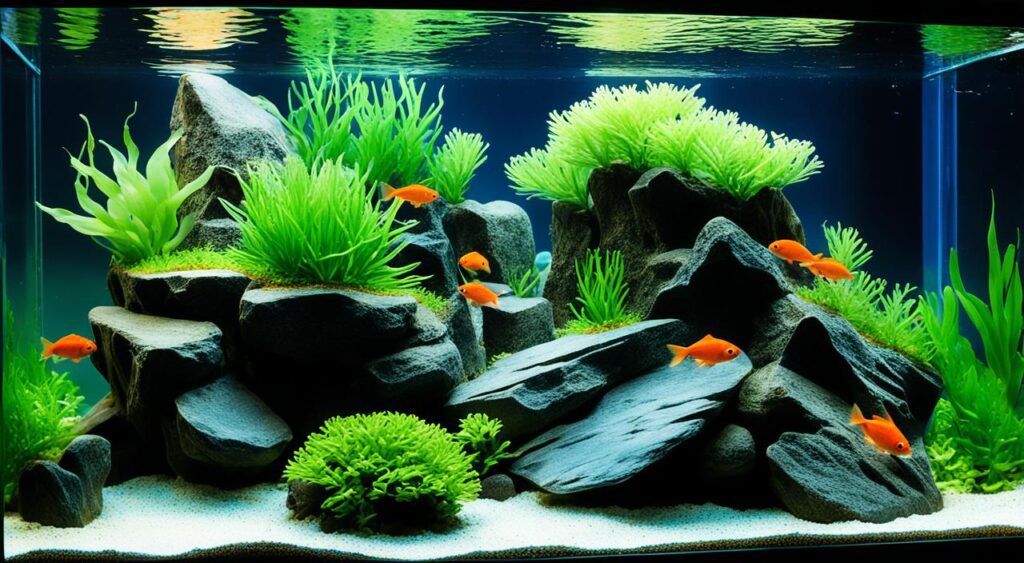
Providing the ideal aquarium environment is crucial for the health and well-being of the Rhomboid Wrasse. This section will discuss the tank size, layout, water parameters, suitable tank mates, and compatibility with live plants and invertebrates.
Ideal Tank Size and Layout
The Rhomboid Wrasse requires ample swimming space, so keeping them in a tank size of at least 90 gallons or larger is recommended. This will provide them with enough room to swim and explore. Additionally, the tank should be well-furnished with live rock and other structures to provide hiding places and territory for the wrasse. This will help create a natural and secure habitat for them.
Water Parameters
Proper water quality parameters are essential for the well-being of the Rhomboid Wrasse. They thrive in a marine aquarium with a temperature range of 72-78°F (22-25.5°C), a pH level between 8.1 and 8.4, and a specific gravity of 1.020-1.025. Regular monitoring of these parameters and maintaining stable conditions is essential to ensure the health of the fish.
Suitable Tank Mates and Potential Conflicts
When choosing tank mates for the Rhomboid Wrasse, it is vital to consider their compatibility. They are generally peaceful and can be kept with other peaceful fish species. However, it is best to avoid aggressive or territorial fish that may bully or harass the wrasse. Famous tank mates for the Rhomboid Wrasse include other fairy wrasses, anthias, gobies, and certain types of dwarf angelfish.
Compatibility with Live Plants and Invertebrates
The Rhomboid Wrasse is reef-safe and can be kept in a tank with live corals and invertebrates. However, caution should be exercised when selecting their tank mates as they may nip at small or delicate invertebrates. It is recommended to provide ample hiding places and ensure that the corals and invertebrates are well-established and can withstand potential nipping.
Care

Maintaining Cirrhilabrus rhomboidalis, or the Rhomboid Wrasse, requires proper care and attention to ensure its well-being. This includes meeting its specific dietary requirements, maintaining optimal water quality, and monitoring for any signs of disease.
Diseases
Like any other fish species, the Rhomboid Wrasse is susceptible to common fish diseases. Awareness of these diseases, their prevention, and the available treatment options is important. Some common fish diseases that the Rhomboid Wrasse can be prone to include:
- Ich (Ichthyophthirius multifiliis) is a parasitic disease characterized by white spots on the fish’s body and fins.
- Velvet (Oodinium): another parasitic disease that causes a yellowish-brown or greyish film on the fish’s skin.
- Bacterial infections: various bacterial infections can affect the Rhomboid Wrasse, leading to symptoms such as open sores, ulcers, and fin rot.
Preventing these diseases involves maintaining a clean aquarium, providing a balanced and nutritious diet, and avoiding overcrowding. Regular water parameter checks and prompt treatment at the first signs of illness are essential for the well-being of the Rhomboid Wrasse.
Diet and Feeding
The Rhomboid Wrasse has specific dietary preferences that should be considered when feeding them in captivity. Being primarily a predatory species, their natural diet consists of small invertebrates and zooplankton in the wild. To maintain a healthy diet, it is essential to replicate their natural feeding habits as closely as possible.
Dietary Preferences
Regarding the Rhomboid Wrasse, their dietary preferences revolve around protein-rich, meaty foods. They are particularly fond of live and frozen foods such as brine shrimp, mysis shrimp, and copepods. These options provide the necessary nutrients and help mimic their natural feeding behaviour.
Recommended Foods and Feeding Schedule
For optimal health, offering a varied diet to the Rhomboid Wrasse is recommended. In addition to live and frozen foods, high-quality pellet and flake foods designed for carnivorous marine fish are essential. This ensures that they receive a balanced nutritional intake. Feeding them small portions multiple times a day rather than a large meal once a day is advisable.
Here is a recommended feeding schedule for the Rhomboid Wrasse:
- Feed small portions of live or frozen foods in the morning.
- Offer high-quality pellets or flake foods in the afternoon.
- Provide additional live or frozen foods in the evening.
Adjust the feeding schedule according to the size and appetite of your fish. Observing their behavior and satiety levels can help determine the appropriate amount of food.
Tips on Ensuring a Balanced and Nutritious Diet
To maintain a healthy diet for your Rhomboid Wrasse, consider the following tips:
- Offer a variety of live, frozen, and pellet/flake foods to ensure a diverse nutritional intake.
- Avoid overfeeding, as this can lead to health issues and poor water quality in the aquarium.
- Supplement their diet with marine-specific vitamin and mineral supplements to enhance their overall health.
- Monitor their feeding habits and adjust their diet accordingly if any signs of malnutrition or weight loss are observed.
By following these tips and providing a well-rounded feeding regimen, you can help maintain the optimal health and vitality of your Rhomboid Wrasse.
Breeding and Reproduction
Breeding the Rhomboid Wrasse in captivity can be challenging due to the limited availability of this rare species. To successfully breed Cirrhilabrus rhomboidalis, it is essential to understand their breeding behaviour and provide the right conditions for reproduction.
Sexing
Sexual dimorphism in the Rhomboid Wrasse is not easily discernible based on physical characteristics alone. To determine the sex of these fish, it is necessary to observe their behaviour during courtship and spawning.
Breeding Behavior and Conditions
During the courtship period, the male Rhomboid Wrasse will display vibrant colouration and engage in elaborate rituals to attract a mate. They may also build nests or clear a spawning site to prepare for breeding. The female will select a suitable male to spawn with.
The ideal breeding conditions for Cirrhilabrus rhomboidalis include a well-established and mature aquarium with plenty of hiding places and live rock. The water parameters should be stable, with a temperature between 78°F and 82°F, pH between 8.1 and 8.4, and salinity between 1.023 and 1.025.
Care of Eggs and Fry
After spawning, the male Rhomboid Wrasse fertilises the eggs and guards them until they hatch. It is crucial to provide a separate breeding tank or dividers within the main aquarium to protect the eggs and fry from other tank inhabitants.
The eggs will typically hatch within a few days, and the fry will become free-swimming shortly after. At this stage, it is essential to provide them with appropriate food, such as rotifers or small artemia nauplii, to ensure their survival and growth.
Challenges in Breeding in Captivity
Breeding Cirrhilabrus rhomboidalis in captivity poses several challenges. The limited availability of this species makes it difficult to obtain a compatible breeding pair. The precise conditions required for successful breeding, including water quality, temperature, and diet, can be challenging to replicate in aquariums.
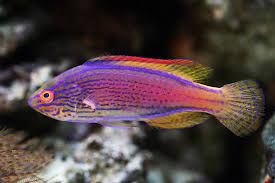 | Add colour and playfulness to your saltwater fish tank with Cirrhilabrus Lineatus, the perfect addition to any aquascaping design! |
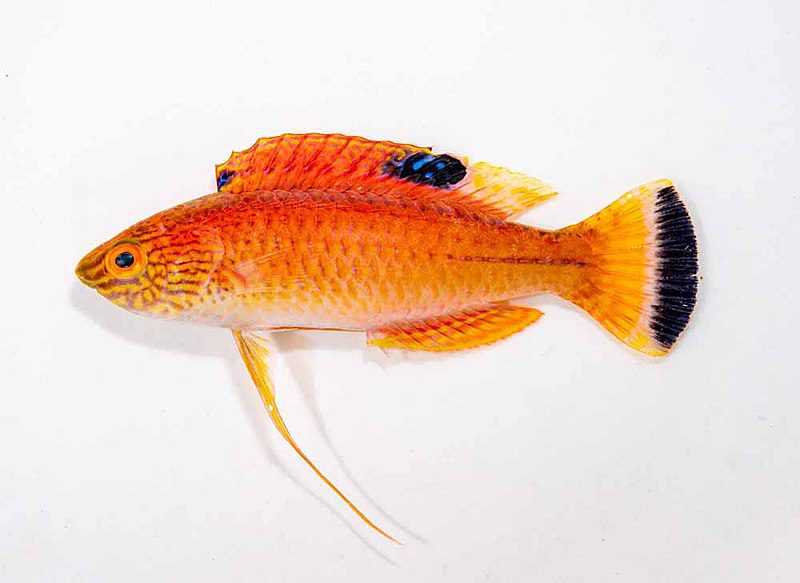 | Experience the vibrant colours and playful behaviour of Cirrhilabrus briangreenei in your saltwater fish tank today! Add some excitement to your aquarium with this unique and beautiful species. |
Summary
In summary, the Cirrhilabrus rhomboidalis, commonly known as the Rhomboid Wrasse or Diamond-Tail Fairy Wrasse, is a visually stunning and highly sought-after fish species in the aquarium trade. Its gold body and blue head make it a vibrant addition to any marine aquarium.
To ensure the well-being of the Rhomboid Wrasse, it is essential to provide it with an appropriately sized tank, optimal water quality parameters, and suitable tank mates. A tank size of at least 90 gallons or larger is recommended to allow ample swimming space for this active species.
The Rhomboid Wrasse has specific dietary preferences and should be offered a balanced and varied diet. This predatory species thrives on small invertebrates and zooplankton, so it is essential to replicate its natural diet as closely as possible in captivity.
Lastly, breeding the Rhomboid Wrasse in captivity can be challenging due to its rarity. However, successful breeding can be achieved with the right conditions and experience. Overall, the Rhomboid Wrasse is a fascinating species that requires careful attention and care to thrive in a home aquarium.

